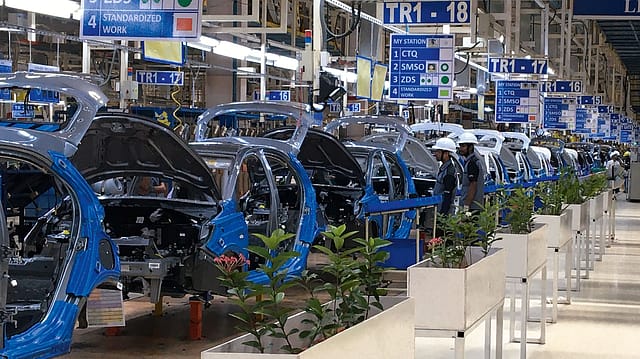Auto component industry’s revenue to grow by 5-8% in FY24 amid export headwinds: ICRA
ADVERTISEMENT

Revenue for the auto component industry is expected to grow by 5% to 8% owing to healthy domestic demand despite a high base and weak export environment, according to rating agency ICRA. The agency expects electric vehicle (EV) opportunities, premiumisation of vehicles, focus on localisation, improved export potential, and regulatory norms changes to translate into healthy growth for auto component suppliers over the medium to long term.
The rating agency expects operating margins of auto ancillaries to improve by 100-150 basis points (bps) year-on-year (YoY) in FY24, thus returning to pre-covid-19 levels of 11-11.5% aided by an increase in content per vehicle, easing of cost pressures and improvement in the supply chain scenario.
"Domestic OEM (original equipment manufacturer) demand constitutes almost 50% of sales for the Indian auto component industry. This is likely to remain healthy in FY2024, with high single-digit growth expected across segments except for tractors. Further, the replacement demand is expected to remain stable in FY2024, growing at 6-8%, supported by underlying demand drivers, including an increase in mobility, improving economic activity, and healthy freight movement. Discouragingly, the export orders have slowed down in the last few months and are likely to remain weak in H1 FY2024, impacted by economic gloom, geopolitical tensions, and supply-chain issues. However, ancillaries will benefit from supplies to new platforms because of vendor diversification initiatives by global OEMs," says Vinutaa S, Vice President and Sector Head, Corporate Ratings, ICRA Limited.
In terms of capital expenditure, the rating agency expects the auto component industry to incur capex of more than ₹20,000 crore in FY24 driven by the production-linked incentive (PLI) scheme launched by the government for automobile manufacturers.
"The industry is expected to incur capex of over ₹20,000 crore in FY2024, with incremental investments being towards new product additions, product development for committed platforms, and development of advanced technology and EV components, apart from capex for capacity enhancements and upcoming regulatory changes. The recently announced PLI scheme will also contribute to accelerating capex over the medium term besides investments by new entrants in the EV segment," Vinutaa says.
December 2025
The annual Fortune 500 India list, the definitive compendium of corporate performance, is out. This year, the cumulative revenue of the Fortune 500 India companies has breached $2 trillion for the first time. Plus, find out which are the Best B-schools in India.
The 44 auto ancillaries (with aggregate annual revenues of over ₹2.5 lakh crore), that ICRA sampled, reported a robust revenue growth of 26% year-on-year (YoY) basis for the first nine months of FY23. For the nine months of FY23, the operating margin for the sampled ancillaries stood at 10%, about 30 basis points (bps) lower on YoY basis. With this, the rating agency says that certain headwinds will continue to persist especially for companies that have a high share of imports, because of the forex volatility.
"While the gradual increase in usage of advanced components that are unavailable in India has contributed to import increase over the years, supply chain disruptions and domestic market recovery contributed to an increase in imports in the last 12-18 months. While forex volatility is a worry for net importers, forex hedging measures adopted and alternate local sources have mitigated the risk to an extent. In the case of components that are unavailable in India, ancillaries are exploring alternate materials and localisation options as measures to mitigate forex and supply-chain risks going forward," the rating agency says.
According to the rating agency, core inflation continues to be a major headwind for the industry. For January and February this year, domestic core inflation remained above RBI’s target limit of 6%. Over the past few months, several automobile manufacturing companies have hiked prices owing to higher input costs.
